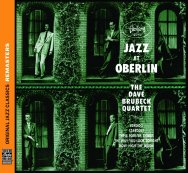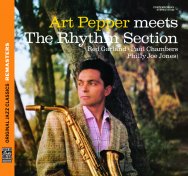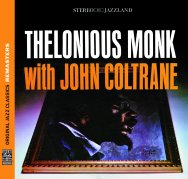Home » Jazz Articles » Multiple Reviews » Thelonious Monk / John Coltrane / Art Pepper / Dave Brub...
Thelonious Monk / John Coltrane / Art Pepper / Dave Brubeck: Remastered Classics
The first five discs, released in March 2010, are pianist Dave Brubeck's Jazz at Oberlin (Fantasy, 1953), alto saxophonist Art Pepper's Art Pepper Meets The Rhythm Section (Contemporary, 1957), tenor saxophonist Sonny Rollins' Way Out West (Contemporary, 1957), pianist Thelonious Monk's Thelonious Monk with John Coltrane (Jazzland, 1961) and guitarist Joe Pass' Virtuoso (Pablo, 1973).
This review surveys the discs by Brubeck, Pepper and Monk.
 The Dave Brubeck Quartet
The Dave Brubeck Quartet
Jazz at Oberlin
Original Jazz Classics Remasters
2010
If 1954 is generally considered to be the year Dave Brubeck became an American celebrity—it was the year he made the cover of Time magazine, the then ultimate seal of establishment approval—the groundwork had begun two years earlier. Prompted by his wife and business partner, Iola, in 1952 Brubeck began booking his quartet on college campuses. It was a radical idea, for jazz at the time was generally considered antithetical with academic life. But the Brubecks pitched to student bodies rather than college authorities, and well-paid bookings flooded in. The initiative revealed a vast, previously untapped audience for jazz, and played a part in the founding of the Newport Jazz Festival in 1954.
Jazz at Oberlin was recorded on March 2, 1953 at Oberlin College in Ohio. The college had one of the most conservative music departments in the country and, fearing for their best grand piano if a jazz musician was allowed to play it, the college authorities permitted Brubeck only to play their number two instrument. Whichever piano they allowed him, some serious retuning would have been necessary after the gig, for Brubeck's percussive, barrelhouse meets the conservatoire style was already in full force by 1953.
Already present too was alto saxophonist Paul Desmond, whose poised, liquid lyricism was Brubeck's perfect foil. Desmond was still on board for Brubeck's "classic quartet" hit album Time Out (Columbia, 1959), whose "Take Five" he wrote, but that album's bassist, Eugene Wright, and drummer, Joe Morello, had yet to join. At Oberlin, the bassist was Ron Crotty and the drummer Lloyd Davis.
The music—up-tempo, heated reimaginings of well known standards—is sublime. While Desmond spins silk from the original melodies, Brubeck reconfigures the changes with extended, block chord passages of furious, dissonant intensity, ramping up even delicate ballads like "These Foolish Things (Remind Me Of You)" and "Stardust" with tent-show fervor. The melodic/rhythmic paradigm that would later produce Time Out was already in place at Oberlin. So too was Brubeck's use of contrapuntalism, heard in the opening theme arrangement of "The Way You Look Tonight."
Crowd noise on albums can be irritating, but the frequent eruptions of cheering and clapping on Jazz at Oberlin are actually enjoyable: listening is to share the excitement as a whole new platform for jazz performance was born. A tremendous album, one of Brubeck's all-time best.
 Art Pepper
Art Pepper
Art Pepper Meets The Rhythm Section
Original Jazz Classics Remasters
2010
Paul Desmond and Art Pepper are often, for the wrong reasons, lumped together. In the 1950s, both were stereotyped, presumably by the hard of hearing, as "cool" players, typical members of the vanilla "West Coast" school. Though both were delightfully lyrical, Desmond and Pepper could, in fact, generate a lot of heat, and did so every bit as often as they kicked back.
In lifestyle and temperament, however, the two men were light years apart, the dapper Desmond contrasting with the full-bore junky Pepper. Much of the 1960s were a wasteland of addiction and prison for Pepper, and he was already living the life when he recorded with trumpeter Miles Davis' rhythm section in 1957, the cycle of incarceration and relapse having begun around 1952.
Fearing he'd back out of the recording session if given too much notice of it, Pepper's wife, Diane, told him about it only a few hours beforehand. In his autobiography, Straight Life (Schirmer, 1979), Pepper wrote that he hadn't touched his horn for six months:
"I got my horn out of the closet...it looked like some stranger...like something from another life...Evidently, the last time I'd played I'd been loaded and I'd left the mouthpiece on the neck...I grabbed the mouthpiece and pulled. It was stuck at first and then all of a sudden it came off in my hand. The mouthpiece had been on the neck so long that the cork had stuck inside, and on the end was just bare metal...There was no way to fix the neck so I put the mouthpiece back on it with the cork and fitted it where it was...If it started slipping or pulling loose or leaking, I was dead...I took the reed off. It was stuck on the mouthpiece, all rotted and green."
Pausing only to curse Diane—"You stinkin' motherfucker, you. I'd like to kill you, you lousy bitch!"—and shoot up a "huge amount" of heroin, Pepper set off to meet the most famous rhythm section in jazz, Davis' tightly honed trio of pianist Red Garland, bassist Paul Chambers and drummer Philly Joe Jones. He had absolutely no idea of the material he might play.
Miraculously, the recording session wasn't a car crash, but a triumph. Between them, the musicians picked some tunes, some of which Pepper had heard but never played before, and without any rehearsal, turned the mikes on and took them out. The adrenalin produced by the circumstances, combined with the feeling of invincibility lent by heroin—a cocktail of industrial proportions—helped Pepper rise to the challenge. His playing on the eight standards and two originals (his own "Straight Life" and the Pepper/Chambers credited "Waltz Me Blues"), burns with equal parts melodic invention and visceral passion, framed by the immaculate, precise, swinging rhythm section.
A blinding album, arguably Pepper's 1950s chef d'oeuvre.
 Thelonious Monk with John Coltrane
Thelonious Monk with John Coltrane
Thelonious Monk with John Coltrane
Original Jazz Classics Remasters
2010
A collection of tracks recorded over four separate sessions between April and July 1957, Thelonious Monk with John Coltrane almost got left in the vaults. The problem wasn't the music—which is among the grittiest Monk or saxophonist John Coltrane ever recorded—but the musicians' contractual arrangements. When producer Orrin Keepnews first took the pair into the studio, he had Monk under contract to his own Riverside label but didn't know that Coltrane had just signed to Bob Weinstock's Prestige. Keepnews approached Weinstock, who said Riverside could record Coltrane providing Keepnews returned the favor by allowing Monk to record an album for Prestige. But Monk, who bitterly remembered his treatment at Prestige years earlier, refused to play ball.
Fortunately, Keepnews decided to carry on recording the duo, hoping that one day he'd be able to release the material. In 1961, an arrangement was arrived at with Weinstock and Thelonious Monk with John Coltrane was pressed.
At the core of the album are three tracks recorded by Monk, Coltrane, bassist Wilbur Ware and drummer Shadow Wilson in July 1957—"Ruby, My Dear," "Trinkle, Trinkle" and "Nutty." By this time, the group was well-seasoned by an extended residency at the Five Spot and the performances are magisterial. Coltrane, who'd been fired from trumpeter Miles Davis' group earlier in the year, and who had since kicked heroin, was with Monk's encouragement discovering his signature, middle-period style. The "sheets of sound" which caused such controversy are there, and so too are passages of feline, balladic elegance.
The other tracks comprise alternate takes from the septet sessions with tenor saxophonist Coleman Hawkins which produced Monk's Monk's Music, and the otherwise solo piano album Thelonious Himself (both Riverside, 1957). Coleman's gruff solo on "Off Minor" is a memorable cameo.
Not so much an album as a collection of tracks from three very different sessions, Thelonious Monk with John Coltrane is given immutable cohesion by the empathy between its two, characterful featured artists—one at the top of his game, the other approaching his—and, of course, Monk's die-cast compositions.
Tracks and Personnel
Jazz at Oberlin
Tracks: These Foolish Things (Remind Me Of You); Perdido; Stardust; The Way You Look Tonight; How High The Moon.
Personnel: Dave Brubeck: piano; Paul Desmond: alto saxophone; Ron Crotty: bass; Lloyd Davis: drums.
Art Pepper Meets The Rhythm Section
Tracks: You'd Be So Nice To Come Home To; Red Pepper Blues; Imagination; Waltz Me Blues; Straight Life; Jazz Me Blues; Tin Tin Deo; Star Eyes; Birks' Works; The Man I Love (Bonus Track).
Personnel: Art Pepper: alto saxophone; Red Garland: piano; Paul Chambers: bass; Philly Joe Jones: drums.
Thelonious Monk with John Coltrane
Tracks: Ruby, My Dear; Trinkle, Trinkle; Off Minor; Epistrophy; Functional; Monk's Mood (Bonus Track).
Personnel: Thelonious Monk: piano; John Coltrane: tenor saxophone (1-5, 7); Wilbur Ware: bass (1, 2, 4, 7); Shadow Wilson: drums (1-5); Coleman Hawkins: tenor saxophone (3, 5); Gigi Gryce: alto saxophone (3, 5); Ray Copeland: trumpet (3, 5); Art Blakey: drums (3, 5).
< Previous
Push
Next >
Raspberry Tongue
Comments
Tags
For the Love of Jazz
 All About Jazz has been a pillar of jazz since 1995, championing it as an art form and, more importantly, supporting the musicians who create it. Our enduring commitment has made "AAJ" one of the most culturally important websites of its kind, read by hundreds of thousands of fans, musicians and industry figures every month.
All About Jazz has been a pillar of jazz since 1995, championing it as an art form and, more importantly, supporting the musicians who create it. Our enduring commitment has made "AAJ" one of the most culturally important websites of its kind, read by hundreds of thousands of fans, musicians and industry figures every month.


















